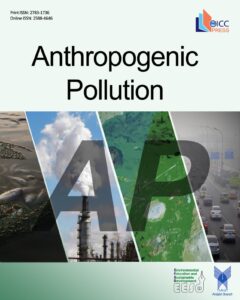Evaluating the importance and application of natural signs and environmental symbols in contemporary Iranian architecture
Authors
Abstract
Symbols and signs stand out as prominent indicators in Iranian architecture. The present research aimed to investigate the importance and application of natural motifs and environmental symbols in contemporary Iranian architecture. This mixed methods research was conducted by analytical and correlational methods. Data were collected using library surveys, observation, questionnaire and Delphi panel, and were analyzed by analytic hierarchy process and statistical methods. The results showed that the environmental symbols in the traditional architecture of Iran included three categories: four main states of matter (four elements: earth, air, fire and water), plant motifs and animal motifs; four main states of matter have been of special importance in both pre- and post-Islamic eras. In the post-Islamic era, the importance and role of symbols changed so that plant motifs were widely used more than animal motifs. Among the sub-criteria, the symbol “earth” had the highest weight (0.966), followed by the symbols “water” (0.874) and “air” (0.863). The lowest weight (0.318) belonged to the symbol “camel”. In the case study of samples between 1941 and 1981, it was found that four elements and plant motifs were observed in 60% and 30% of the samples, respectively, while animal motifs were not used in any of the studied samples. To conclude, the animal motifs, unlike four elements and plant motifs, have not had an impact on contemporary architecture.
Keywords
- Environmental symbols
- Four main states of matter
- Animal motifs
- Plant motifs
- Contemporary architecture
References
Ahmadi B, (2014) Truth and Beauty: Lessons from Philosophy. Markaz Publications, Tehran, Iran.
Ahmadi M, Teymouri P, Dinarvand F, Hoseinzadeh M, Babaei AA, Jaafarzadeh N, (2014) Municipal solid waste landfill site selection using analytical hierarchy process method and geographic information system in Abadan, Iran. Iranian Journal of Health Science, 2 (1): 37–50. http://jhs.mazums.ac.ir/article-1-142-en.html.
Baharloo P, Sotoudeh S, Porzargar MR, (2019) The role of symbols and signs as the background factors of contemporary architectural developments. 6th National Congress on Civil Engineering, Architecture and Urban Development, Tehran, Iran. https://civilica.com/doc/1003339.
Bagheri S, Einifar A, (2017) A classification of semiotics in architecture: the delimitation and clarification of manifestation and the inclusion domain of semiotics in architecture. Armanshahr. -(17): 1-10. https://sid.ir/paper/202372/en
Behbahani Eslami M, Jalili T, Kabuli A, (2016) A study of symbolism in Iranian-Islamic architecture. The First annual scientific-specialized conference of civil engineering, architecture, urban planning and geography science of ancient and contemporary Iran, Tehran, Iran. (In Persian).
Bemanian MR, Derazgisou S, Salem P, (2013) A comparative study of the application of symbols in Safavid and Iranian contemporary architecture. Naqshejahan-Basic studies and New Technologies of Architecture and Planning. 3 (2): 13-21. https://sid.ir/paper/485831/fa.
Bertolini M, Braglia M, (2006) Application of the AHP Methodology in Making a Proposal for a Public Work Contract. International Journal of Project Management. 24: 422-430.
https://doi.org/10.1016/j.ijproman.2006.01.005.
Beskese A, Demir HH, Ozcan HK, Okten HE, (2015) Landfill site selection using fuzzy AHP and fuzzy TOPSIS: a case study for Istanbul. Environmental Earth Sciences. 73 (7): 3513-3521. https://link.springer.com/article/10.1007%2Fs12665-014-3635-5
Heydari M, Hashem Zahi S, Yousefi H, (2018) Psychology of color in contemporary Iranian architecture and urban planning. 3rd International Conference on New Findings of Iranian Architecture and Construction Industry, Tehran, Iran.
Khaki A, (2021) An introduction to geometric patterns in Iranian architecture from ancient times to the present day. llamology Studies Quarterly, 6(19), 60-79.
Khorsandi Kohanestani E, Qarakhani A, (2017) Conceptualization of decorations, materials and symbols used in Iranian-Islamic architecture. Research Conference Architecture and Urbanism islamic History of Iran, Shiraz, Iran.
Khorsandi H, Faramarzi A, Aghapour A, Jafari SJ, (2019) Landfill site selection via integrating multi-criteria decision techniques with geographic information systems: a case study in Naqadeh, Iran. Environmental Monitoring and Assessment. 191: 730. https://doi.org/10.1007/s10661-019-7863-8
Maroufi A, (2016) Symbolism and its influence on the contemporary architecture of Iran. International congress of new developments in sustainable architecture and urban planning, civil and structural engineering, Istanbul, Turkey. https://civilica.com/doc/575659.
Mohebbi Germi H, Farmahini Farahani R, Ghiai MM, (2021) The Course of the Influence of Symbols and Signs in Explaining the Meaning of Architecture in Qajar Historical Houses; (Case Studies: Cities of Ardabil, Tabriz and Urmia). Islamic Art Studies. 18 (43): 517-529. 10.22034/ias.2021.296678.1669
Quchani M, (2017) Investigating the role of symbols in the creation of meaning in the body of Islamic Iranian architecture. The First National Conference of Symbology in Persian Art with a Focus on Native Art, Bojnourd, Iran.
Rathore S, Ahmad S, Shirazi S, (2016) Use of the suitability model to identify landfill sites in Lahore-Pakistan. Journal of Basic and Applied Sciences. 12: 103-108.
Rezaei SM, (2012) Symbolism and Semanticism in Islamic Architecture, The National Conference on Iranian- Islamic Architecture and Urbanism, Mashhad, Iran.
Shahbazi, M, Mirzaei Q, Mohammadi Kia M, (2013) The Role of Natural Elements and Symbolism in Islamic Arts and Sufism. Journal of Religion and Mysticism, 8(32), 223-242. https://sid.ir/paper/191274/fa
Sakizadeh M, Jafari Dehkordi N, (2017) Application of Islamic motifs in contemporary Iranian symbols, The First National Symposium on Global Graphics Day, Tehran, Iran. https://civilica.com/doc/798364/.
Tabatabai SZ, Hemmati MM, (2014) Concept of the basics of symbols and aesthetic signs in Iranian-Islamic architecture (Dezful houses). The First National Conference on Geography, Urban Planning and Sustainable Development, Tehran, Iran.
Torabi Z, Asadi S, (2015) Recognition and explaining the concept of "symbol" in architecture according to the opinions and theories of scholars. Art Quarterly Book Review. 3 (9-10): 253-296.




